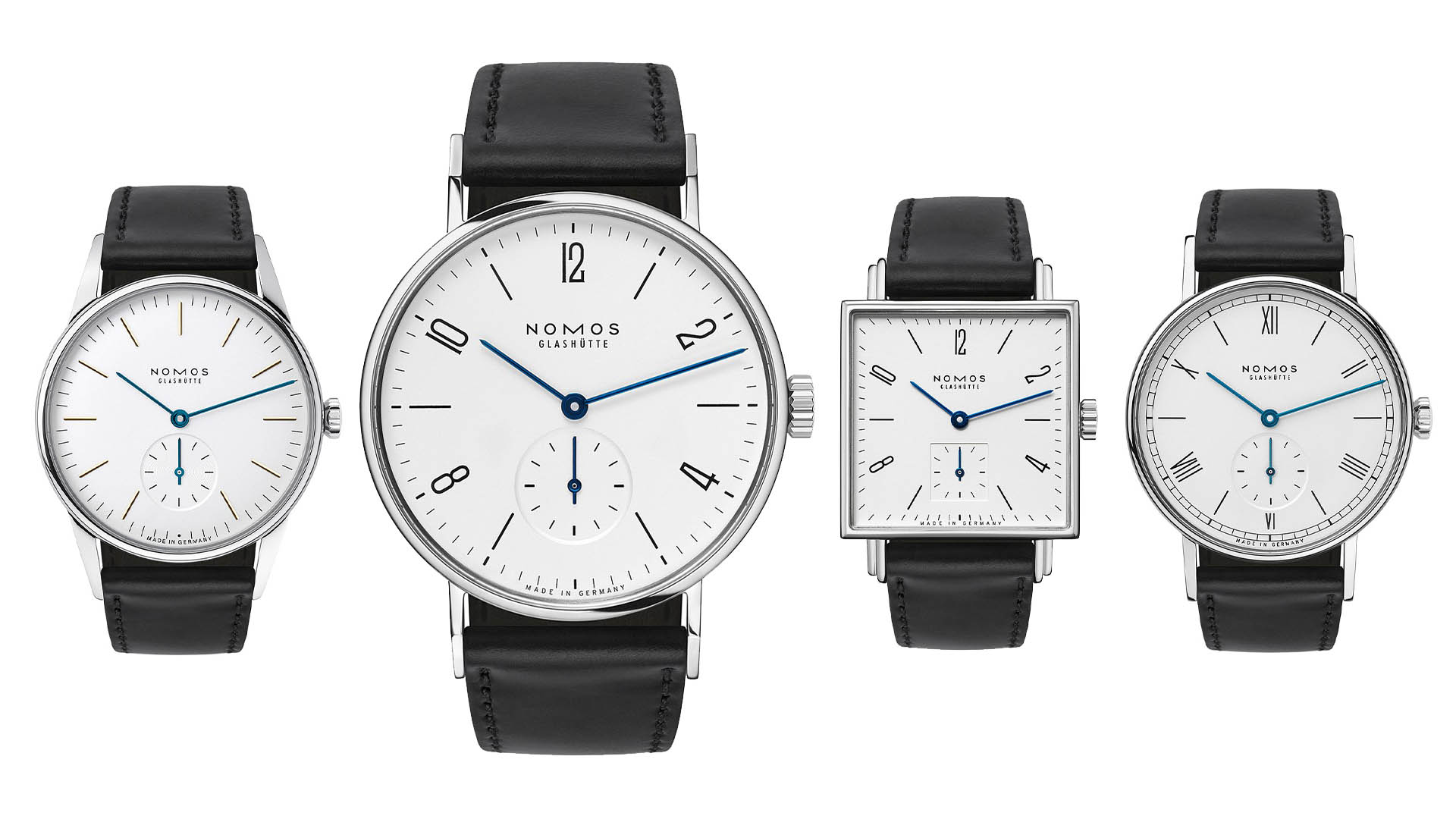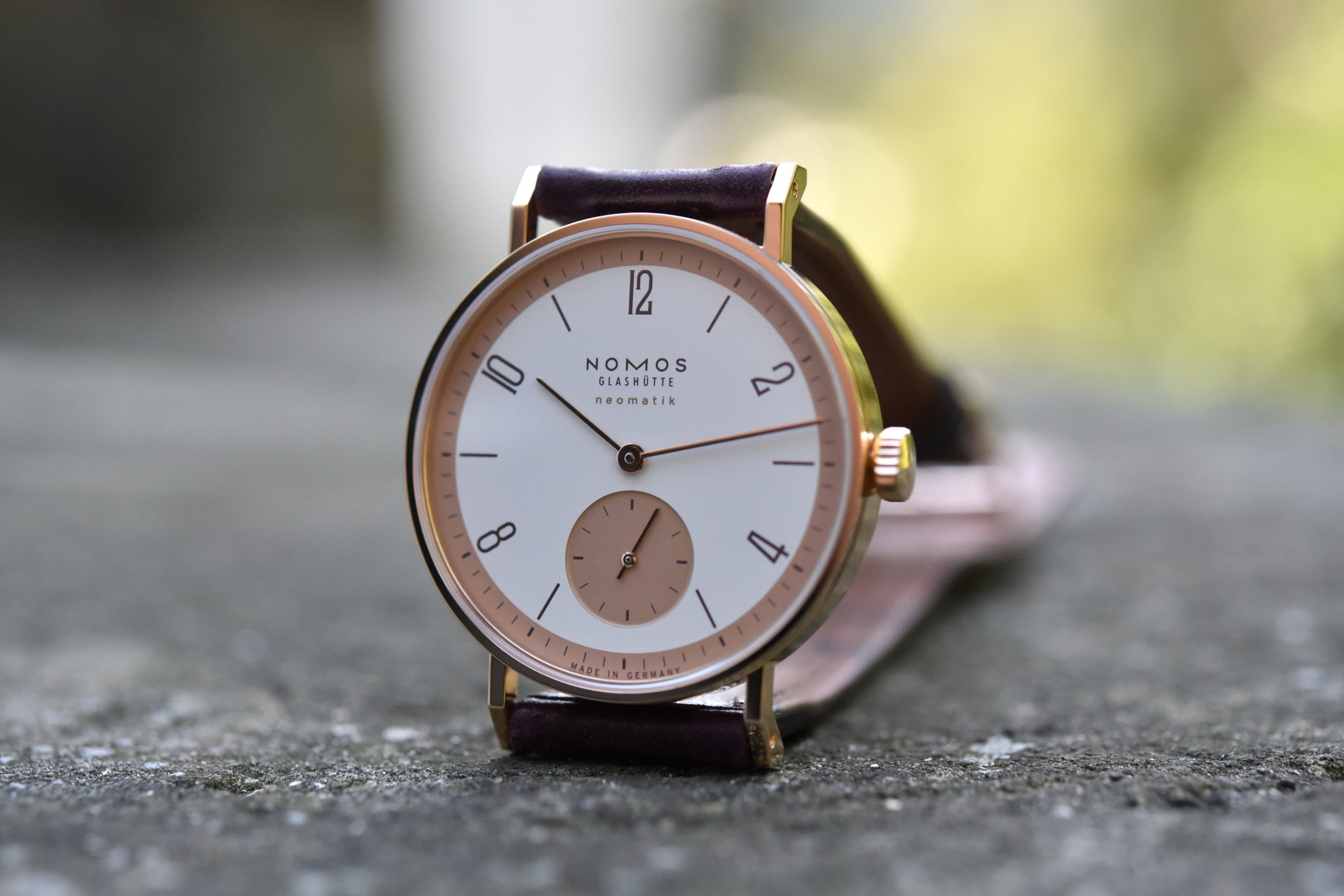The Nomos Tangente Roségold Neomatik Marks the Return of the So-Called Lange Dial (incl. Video)
A devilishly handsome gold edition of the iconic Tangente to bring back the emblematic Lange dial.
The Glashütte region in the South-East of Germany is the cradle of German mechanical watchmaking. The small town is home to some of the most revered historic watchmaking houses in the industry. Nowadays, you’ll find names like A. Lange & Söhne, Moritz Grossmann and Glashütte Original, all headquartered there. But there’s one brand from this region that should be on everyone’s radar: Nomos! Founded by Roland Schwertner in 1990, shortly after the Berlin Wall came down, the brand launched its inaugural quartet of the Orion, Ludwig, Tetra and Tangente just two years later. All four models are still part of the collection today, but the Tangente has become a true icon for the brand. But one particular reference is praised among collectors and is now staging a comeback: the so-called Lange dial! This was first launched in the late 1990s and is one of the most sought-after watches by Nomos. It returns in a devilishly handsome Tangente, however, which is also a celebration of 175 years of Watchmaking in the Glashütte region. This is our live look at the Nomos Tangente Roségold Neomatik.
The watchmaking history of the Saxony region, which Glashütte is part of, started almost two centuries ago. Ferdinand Adolph Lange, a name you should be familiar with, famously set up a watchmaking atelier in Glashütte in 1845. It took years to build the industry, but eventually, the people of Glashütte succeeded, even opening up a watchmaking school in the city in 1878. Nomos is one of the youngest brands to emerge from this region but one that’s made quite a significant impact. The Nomos style is easy to spot, with clean Bauhaus-inspired designs using simple elements and clear indications. But as we’ve recently spoken about, there’s always a little twist to be found, whether aesthetically or mechanically. And by far the most important watch for the brand is the Tangente.

Among the dozens of editions of the Tangente that have been created over the years, one is of particular significance to collectors. Nicknamed the Lange dial, this watch presented in the late 1990s featured a two-tone off-white and beige coloured dial that was directly inspired by dials made in the 1930s, for instance, for Lange. This bicolour dial, almost like a sector dial, has since become one of the most collectable versions of the Tangente and of any Nomos watches. The so-called Lange dial is now back in the collection to celebrate 175 years of watchmaking in Glashütte.
For the occasion, Nomos has crafted the Tangente from 18k 4N rose gold. One of Nomos’ main goals is to keep the dimensions of all watches in check, both in width and height. For the Tangente, this means a compact 35mm wide by 6.9mm slim case with a fully polished finish. The typical straight and angled lugs have drilled holes to swap straps without too much effort. The case design draws inspiration from the 1930s and recalls the design of many watches produced in the Glashütte area at the time from brands like Lange and (from the Black Forest region) Stowa. A flat sapphire crystal covers both the front and back of the watch.
Alongside the precious metal case, the most important element of this Tangente Roségold Neomatik is its two-tone dial, somehow bringing back the so-called Lange dial. The minute ring and small seconds subdial are rose gold-coloured and paired with burgundy printed indices and markings. Details such as the crisp font for the numerals interchanged with simple stick markers and slender, straight hands are what make the Tangente such a design classic. The dial shows the brand’s logo, also printed in burgundy and the ‘Neomatik’ movement designation.
Flipping the watch over reveals the Tangente’s mechanics. Instead of the hand-wound Alpha movement you might expect, this special edition comes with the automatic DUW 3001 calibre, produced in-house. And as we’ve grown accustomed to, the finishing of this movement is very nicely done with perlage, Glashütte ribbing, blued screws etc. The DUW 3001 calibre measures only 3.2mm in height, which is the prime reason for the slender build of the Tangente. It runs at a frequency of 21,600vph and delivers a power reserve of 43 hours. But I doubt future owners of this devilishly handsome Tangente will put it away long enough to have it run out of energy!
A consequence of using precious metals for the case is that the Tangente Roségold Neomatik, as this is officially called, comes at quite the premium over the stainless steel Tangente. Using rose gold means this special edition retails for EUR 8,600, whereas its classic time-only siblings are about a quarter of that.
It is strapped to a burgundy-coloured Horween Shell Cordovan leather strap with a rose gold Nomos Wing buckle. Limited to 175 pieces, this will find its way to collectors quite easily despite the considerable premium it demands. For it, you get a lot of watch in return despite its simple appearance. And to us, it is another fitting tribute to the inimitable style of Saxony watchmaking and more importantly, it marks the comeback of the Lange dial, a collector’s favourite!
For more information, please visit Nomos-Glashuette.com.













3 responses
Hey Robin
Thanks for the informative article on a beautiful watch. It is really on the way of becoming a classic, some might argue it already is (despite similar Bauhaus designs from other brands).
This new version truly is a fitting celebration of watchmaking in the region.
However, I think there is a tiny bit of incorrect info in the section on the design of the dial. Stowa are not in Glashütte, let alone in Saxony. They have their HQ in the Black Forest region of Germany, which is in the south-west of the country.
Best
Sebastian
Got to make one comment. The models that’d be 1/4 the price, are NOT the neomatiks, they’d be the alphas. The standard model 35 mm Tangente Neomatik is about $3500. Granted, still a steep additional cost, but gold is expensive right now.
Otherwise…that color scheme won’t appeal to everyone, but it’s a really nice piece.
Thank you very much for the kind feedback, and you’re of course 100% right about the origins of Stowa being the Black Forest region. I’ve updated it slightly in the article. Glad you like the article!
Best, Robin.